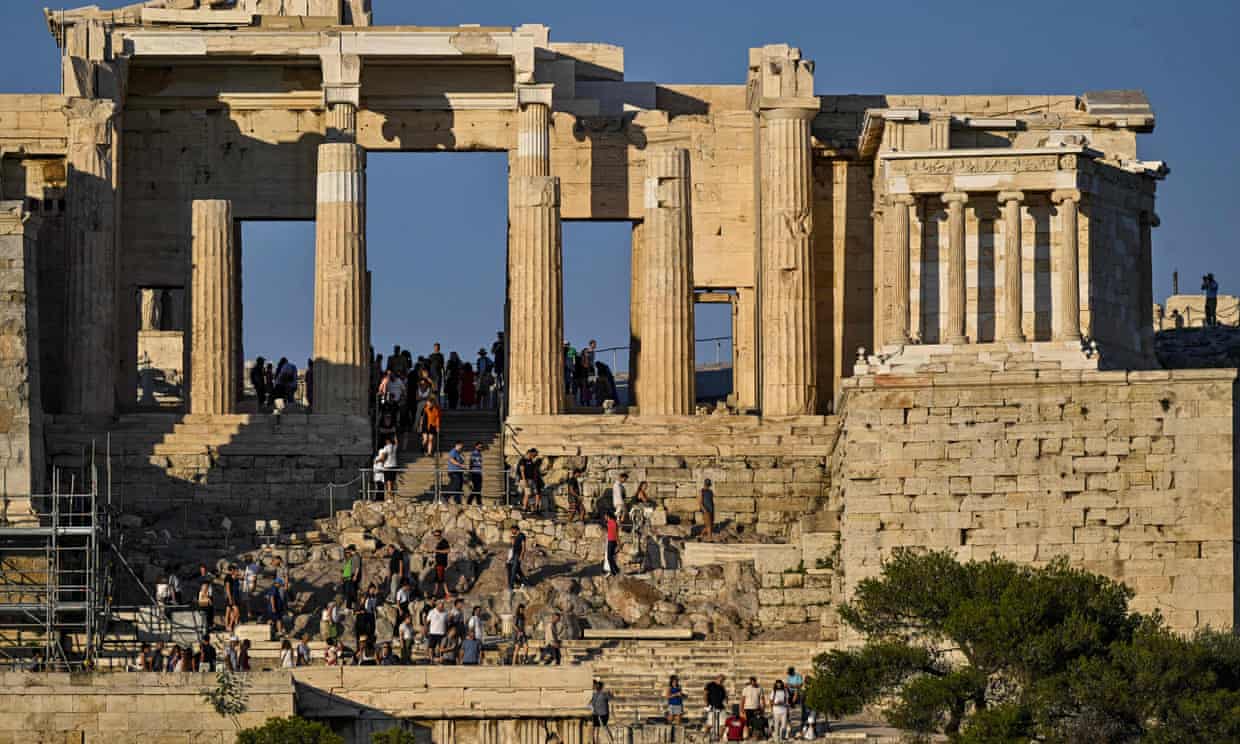
Acropolis now: Crisis as soaring visitor numbers overwhelm Greek treasure
With cruise ships decanting thousands of tourists in Athens, tough new controls have been imposed at the country’s most visited site
Helena Smith in Athens
Sun 9 Jul 2023 10.00 EDT
It’s official: more than 25 centuries after it was built and nearly 200 years after it began attracting tourists, the Acropolis will adopt crowd control policies to ease the very modern plague of soaring visitor numbers.
Unprecedented queues at the foot of the site, a dramatic rise in sightseers since the Covid-19 pandemic and unruly scenes at the gateway to the sanctuary have spurred the Greek government to take action.
“Measures will be fully enforced by the end of the month,” the country’s cultural minister, Lina Mendoni, announced last week. “Visits in June and early July alone increased by 80% compared to 2019.”
A time-slot system, fast-lane entry points for organised tourist groups and electronic ticketing are among the steps officials say will help alleviate visitor congestion.
As the country’s most visited site, the Acropolis is said to draw more than 17,000 people daily – a reflection of the over-tourism that has affected Greece in recent years.
Once implemented it is hoped the policies will ease the problem of queues exacerbated by the arrival of gargantuan cruise ships decanting thousands of passengers at the Greek capital’s port of Piraeus. “In the past these cruise ships had the capacity to carry a few thousand, the population of a large village,” said Lysandros Tsilidis, president of the Federation of Hellenic Associations of Tourist and Travel Agencies, which has welcomed the measures. “Now the vessels are so big you’ve got the size of a small state on board and at least 30% of all of those passengers will have pre-purchased tickets to visit the Acropolis.”
At 72, Tsilidis has seen Greece transformed from a popular, if less well-known, Mediterranean destination in the 1970s to one of the planet’s three most visited countries in 2022.
“No one could possibly have imagined it,” he says. “Back then, Greece attracted 7 million tourists; now that number is more than 30 million, three times our population.”
From a little before 8am on Friday, tourist queues could be seen snaking down from the ticket booths outside the entranceway to the Acropolis to the great cobblestone boulevard that runs the width of the south side of the monument. By mid-morning those who had yet to make the climb up the hill to the Periclean treasure, and who had not come with hats and umbrellas, desperately sought respite from the searing sun under olive trees in the absence of any shade.
Tour guides increasingly have spoken of people fainting in the heat in an area where any intervention is controversial because of the sacred nature of the site.
“I have given instructions to find a way to be able to erect shades in places that are [not considered] sensitive,” said Mendoni, who spent much of her first week back in office – after her reappointment in the wake of general elections – witnessing the crowds at the Acropolis. “And at discreet points we’ll make sure there is water outside the site.”
A classical archaeologist by profession, Mendoni oversaw the installation of concrete pathways across parts of the rock on which the temples stand during her first term in the post. The walkways, created during the pandemic when the Parthenon was off limits, were criticised by some as a monstrosity.
Announcing the new visitor management plan, she raised the prospect of further interventions, saying congestion at the site could ultimately only be solved if the Acropolis’s majestic gateway was enlarged. “In antiquity there was more than one entrance [to the temples],” she said. “In my view the solution to … the bottleneck [of visitors at the entrance] would be the expansion of the Propylaia [gateway]. We can’t demolish the Propylaia but we can widen it.”
On Friday, Manolis Korres, the architect who heads the Committee for the Conservation of the Acropolis Monuments, told the Observer that he believed the works would take no longer than 10 months if a “well-prepared schedule” was adhered to.
“I have proposed the reinstatement of the Roman staircase in the area many times and never because I want to facilitate the number of visitors,” said the professor, whose detailed studies would see the monumental entrance enlarged and overhauled to much of its original form.
“Even if there were 10 visitors a day to the Acropolis I believe it should be restored because it would add to a better understanding of the site.”
The ascent up to the treasures – a gruelling climb in the summer – would also be easier as the incline “would be eight times wider”, said Korres, regarded as the Acropolis’s leading authority.
The spectre of further alterations to the monument is unlikely to pass lightly amid protests that changes – including the introduction of an illuminated, ultra-modern lift – have pandered more to mass tourism than saving the country’s premier site.
Mendoni disagrees. “If we hadn’t made the corridors,” she said, referring to the concrete pathways last week, “the Acropolis would today be an almost impossible monument to visit.”
SOURCE: https://www.theguardian.com/world/2023/jul/09/acropolis-greek-tourists-cruise-ships-athens-controls

